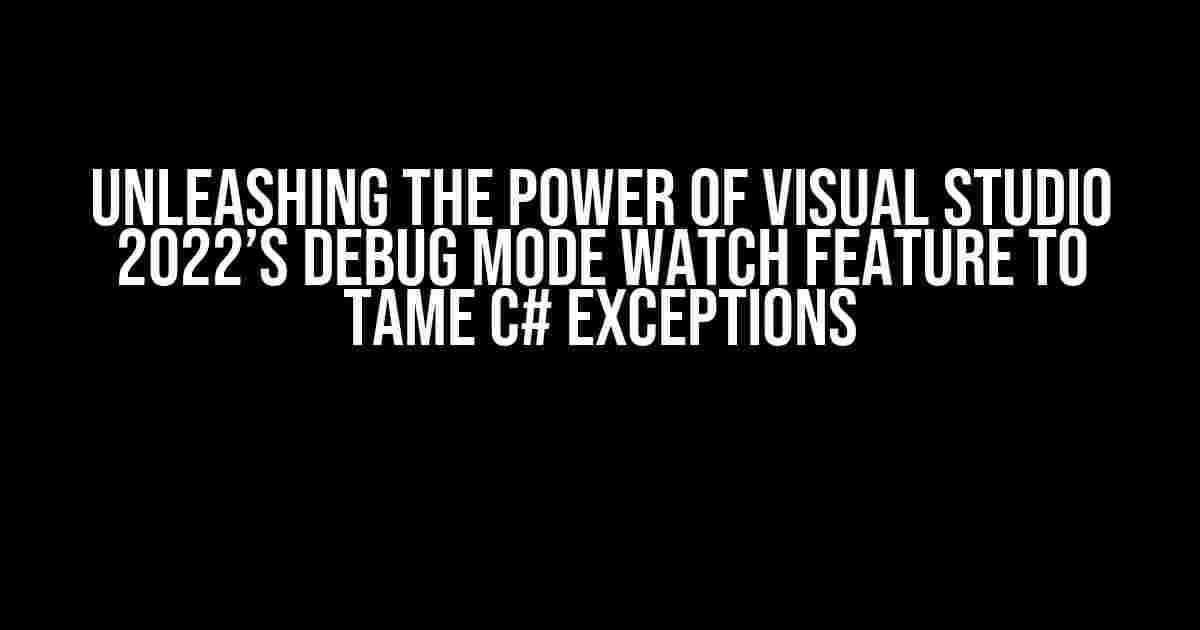Are you tired of dealing with the frustration of general C# Exceptions in your .NET applications? Do you wish there was a way to narrow down the issue to a more specific exception-type class? Look no further! Visual Studio 2022’s Debug mode Watch feature is here to save the day. In this article, we’ll dive into the world of debugging and explore how to harness the power of the Watch feature to tackle those pesky exceptions with ease.
What’s the Problem with General C# Exceptions?
In C#, when an exception occurs, the default behavior is to throw a general Exception object. While this provides some information about the error, it can be quite vague, making it challenging to identify and fix the root cause of the problem. The Exception class is the most general exception type in C#, and it’s often too broad to be of much use.
For instance, when you catch a general Exception, you might see an error message like “Exception of type ‘System.Exception’ was thrown.” This message doesn’t provide much insight into what went wrong or where the issue lies. You’re left wondering what specific type of exception occurred, making it difficult to write effective error-handling code.
Enter Visual Studio 2022’s Debug mode Watch feature
Visual Studio 2022’s Debug mode Watch feature is a game-changer when it comes to debugging exceptions. This feature allows you to inspect the values of variables and expressions while your application is running, giving you a deeper understanding of what’s happening behind the scenes.
The Watch feature is particularly useful when dealing with exceptions. By adding a watch to the exception object, you can drill down into the specific exception type and get more detailed information about the error.
Step-by-Step Guide to Using the Watch feature to Narrow Down Exceptions
Follow these steps to use the Watch feature to narrow down exceptions to a more specific exception-type class:
-
Start by setting a breakpoint in your code where the exception is occurring. You can do this by clicking in the left margin next to the line of code.
-
Run your application in Debug mode by pressing F5 or clicking the “Start Debugging” button.
-
When the exception is thrown, the debugger will pause at the breakpoint. In the Debug menu, select “Windows” and then “Watch” to open the Watch window.
-
In the Watch window, type the name of the exception object, usually “ex” or “e”, and press Enter. This will add the exception object to the Watch list.
ex
-
Expand the exception object in the Watch window by clicking the “+” icon next to it. This will reveal the exception’s properties and values.
-
Look for the “GetBaseException” property and expand it. This property will give you the underlying exception that caused the error.
ex - GetBaseException - ... -
Continue expanding the exception hierarchy by drilling down into the “GetBaseException” property until you reach the root cause of the error. You may need to repeat this process several times.
-
Once you’ve reached the root cause, take note of the specific exception type and its properties. This information will give you a better understanding of what went wrong and help you write more targeted error-handling code.
Example Scenario: Handling a FileNotFoundException
Let’s consider an example scenario where we’re trying to read a file, but it doesn’t exist. We’ll use the Watch feature to narrow down the exception to a more specific exception-type class.
Here’s the code:
try
{
using (StreamReader reader = new StreamReader("nonexistentfile.txt"))
{
string content = reader.ReadToEnd();
Console.WriteLine(content);
}
}
catch (Exception ex)
{
Console.WriteLine("Error: " + ex.Message);
}
When we run this code, a FileNotFoundException is thrown. Let’s use the Watch feature to investigate.
In the Watch window, we add the exception object “ex” and expand it:
ex
- GetBaseException
- FileNotFoundException
- FileName: "nonexistentfile.txt"
- FusionLog: ""
- Message: "Could not find file 'C:\nonexistentfile.txt'."
- ...
Aha! We’ve narrowed down the exception to a FileNotFoundException, which provides more specific information about the error. We can now use this information to write targeted error-handling code, such as checking if the file exists before trying to read it.
Tips and Tricks for Using the Watch feature
Here are some additional tips and tricks for getting the most out of the Watch feature:
-
Use the ” Autos” window instead of the Watch window to automatically display the values of variables and expressions in the current scope.
-
Press F10 to step over the current line of code and inspect the values of variables and expressions in the Watch window.
-
Use the “Console” window to execute expressions and inspect their values. This can be useful for testing and debugging code snippets.
-
Right-click on a variable or expression in the Watch window and select “Add to Watch” to add it to the Watch list.
-
Use the “Immediate” window to execute commands and inspect their values. This can be useful for executing arbitrary code during debugging.
Conclusion
Visual Studio 2022’s Debug mode Watch feature is an incredibly powerful tool for debugging exceptions in C#. By using the Watch feature to narrow down exceptions to a more specific exception-type class, you can write more targeted error-handling code and improve the overall reliability of your .NET applications.
Remember, the key to mastering the Watch feature is to practice, practice, practice! With time and experience, you’ll become proficient in using this feature to tackle even the most challenging debugging tasks.
So, the next time you’re faced with a general C# Exception, don’t panic! Reach for the Watch feature and start drilling down into the exception hierarchy. You’ll be amazed at how quickly you can identify and fix errors, and your users will thank you for it.
| Keyword | Visual Studio 2022’s Debug mode Watch feature |
|---|---|
| Benefits | Narrows down exceptions to a more specific exception-type class, providing more detailed information about the error. |
| Use cases | Debugging exceptions in C#, identifying root causes of errors, and writing targeted error-handling code. |
| Tips and tricks | Use the Autos window, press F10 to step over code, use the Console window, and right-click to add variables to the Watch list. |
By leveraging the power of Visual Studio 2022’s Debug mode Watch feature, you’ll be well on your way to becoming a debugging master and creating more robust, error-free .NET applications.
Frequently Asked Question
Get ready to level up your debugging game with Visual Studio 2022’s Debug mode Watch feature!
Q1: What is the Watch feature in Visual Studio 2022’s Debug mode?
The Watch feature allows you to monitor the values of variables, expressions, and registers in your code while debugging. It’s like having a superpower that lets you peek into the inner workings of your program!
Q2: Why is it important to narrow down an exception to a more specific exception-type class?
Narrowing down an exception helps you identify the root cause of the issue more efficiently. By specifying a more precise exception type, you can write more targeted catch blocks and handle errors with greater precision, making your code more robust and reliable.
Q3: How can I use the Watch feature to narrow down an exception to a more specific exception-type class?
In the Watch window, you can add a breakpoint where the exception is thrown, then use the “Watch” feature to inspect the exception object. You can then drill down into the exception’s properties and inner exceptions to identify the specific exception type that’s causing the issue.
Q4: Can I use the Watch feature to debug exceptions in async code?
Yes, you can! Visual Studio 2022’s Debug mode Watch feature supports debugging of async code, including exceptions. You can use the “Task” window to inspect the async operation and identify the exception that’s being thrown.
Q5: What are some best practices for using the Watch feature in Visual Studio 2022’s Debug mode?
Some best practices include setting breakpoints strategically, using the “Autos” window to see the most relevant variables, and using the ” Locals” window to inspect local variables and parameters. Additionally, you can use the “Watch” window to inspect expressions and registers, and use the “Immediate” window to execute commands and evaluate expressions.



